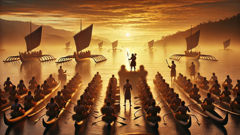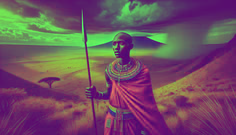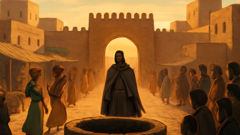Introduction
Mist and salt and the slow hush of reef met the island at first light. In Samoa, where the sea sings names older than any living memory and the banyan trees keep watch like elders in council, stories begin in small, fierce ways. One such beginning begins with a wound that would not fully close—a blood clot carried within a woman's body that, touched by prayer and the surf, became more than a sign of loss. It became a presence, a power, a child born with the thunder of two worlds in her bones. They named her Nafanua: messenger of utterance and guardian of the land. From the practicing mats in village fale to the whispered corridors of sacred groves, her appearance changed how people remembered the meaning of courage and command. This is not a simple tale of battle. It is about how a people wear destiny like a finely woven tapa, how elders recognize a spirit wrapped in human form, and how villages shaped their laws and peace beneath the shadow of a woman whose hands could split the air and whose counsel could still the sea. Listen to the story of Nafanua not only as memory of a war won, but as an origin for leadership, ritual, and the many ways a community claims strength through myth.
Origins and Omens: The Birth of a Warrior
The story begins with an ordinary grief turned extraordinary. In a small coastal village where the reef forms a crescent like an arm cradling a sleeping child, a woman who had given much to her people carried a wound that could not be soothed by herbs or prayer. She was of noble line—her ancestors were navigators, healers, and chiefs whose names were carved into the memory of reef stones and family gardens. When her labor came, it did not deliver a child in the way people expected. Instead, after long nights of whispered incantations and the rhythmic pounding of sennit, the midwife found a small, crimson clot cradled like a stone in the hollow of a woven mat. The village, full of its customary tenderness, saw this clot as a sign: both of loss and of something that refused to fade. They wrapped it in fragrant cloth and placed it near the hearth where women's voices keep the house warm. They carried it to the foreshore where the water offers its blessings, and the elders debated whether the omen spoke of danger or of power.

As the sun dipped and the moon rose round and clean, the clot swelled with a curious light. The chief’s daughters slept with their arms across their chests as though holding a heart; the fishermen awoke with the taste of iron on their lips. That night the sea answered the village drum with a new rhythm—the long, slow breathing of waves in a different key. A dream walked through the families: a woman, tall as a coconut palm, skin like burnished tapa, hair braided with shells and banana fiber; her eyes like the surf when the storm rolls in and disappears just before dawn. She would be the one to stand when others sat, to speak when the council hesitated.
In the third night, under a sky scattered with small sharp stars, the clot opened—not with pain but with a soft, resilient sound like the snapping of dried reeds. From it came a child, not crying in the way newborns cry, but with a single-syllable utterance that the elders believed to be a name—and perhaps a command. They named her Nafanua: a name that carries both song and spear in its breath. The women who had kept the clot swore they felt the village’s lineage rearrange itself around that small being. Tools were brought, not for house work, but for shaping weapons and woven shields. The smiths consulted the gods of fire and iron. Women who taught tapa began to whisper knot-work patterns that hid stories of tides and battles.
Omen and ritual changed the village’s daily rhythm. Nafanua grew quickly, as if the island wanted to make up time for her unusual beginning. She moved with a predator’s grace and a leader's calm; at three, she could still a room by holding up her hand. Children who once chased crabs at the reef found themselves falling quiet when she walked past, as though a small wind preceded her steps and carried with it confidence. Elders saw in the tilt of her head the lines of an old chief, in the set of her jaw the stubbornness of a navigator who had turned a canoe homewards through storm when others would have given up. Her presence became a study in paradox: gentle as the breadfruit’s shade one moment, hard as basalt the next.
People from neighboring islands began to bring offerings: pandanus mats, smoked fish, and the carved fan-shaped implements that the people used in ceremonial dances. They left them at the steps of the meeting house and then returned home, talking in awed tones about a girl who walked like a storm and spoke like the sea. Word carried farther than any of them expected. If a signal fire lit at dusk and a new canoe slipped the reef at dawn, there would be talk of her name on the wind. Yet the village elders did not rush to put weapons into children’s hands. They taught Nafanua music and law, song-lines that map the reef and the forests, the genealogies that tie a family to a place. They gave her the heavy responsibility of learning which words could heal and which could wound; how to speak in council without shaming; how to strike without losing sight of the reason to strike at all. The dual education of warrior and wise woman prepared her for a path that would test every seam in her being.
When the first whispers of war came—a neighboring confederacy that had long coveted the fertile valleys and reef-sheltered harbors—the village watched the edges of their world rearrange. Skirmishes flared like reef-fire; canoes came home with splintered paddles and stories of groups gathering beyond the horizon. The elders called for Nafanua. She walked into the meeting circle barefoot, hair wrapped in tapa like a crown of woven dusk, and the villagers saw the future’s presence standing quietly among them. Nafanua listened to the complaints, the pleas, the arrangements made from fear and pride. She did not promise swift victory. She promised order and movement: the right people in the right places, signals that would be read as songs by those on the water, and weapons forged in the specific way the gods approved. It was a kind of leadership the islands had not seen in a generation; more importantly, it was a leadership that transformed a marrow of grief into a sword for the people’s protection.
She taught the men and the women to use paddles not merely as tools of travel but as extensions of the body in battle formations. She took the old ritual fans and turned them into standards of alignment; she taught the drumming patterns that told a fleet when to break and when to hold. But her most remarkable gift was the way she tied courage to law. She ordered that no victory should be cheapened by pillage; that the captains must respect the sacred groves and the protocols of war, and that after conflict there must be rites to stitch the community back together. It was this blend of fierce strategy and careful ritual that began to shift the balance. The legend of Nafanua’s birth—once a whisper—melted into a plan with a heart, a warcraft bound by the spine of cultural restraint.
As canoes were lashed and shields polished, the island held its breath. In the night before the first decisive clash, Nafanua walked alone to the reef. She waded with the tide, palms opened to the ocean, and in the cold flush of moonlight she addressed the gods who keep the island's fortunes. Her voice, the villagers would say afterward, became a bridge between land and sea, between blood and custom. The gods answered not with thunder but with a swell of wind that smoothed the surface of the water and the soft scent of iron in the air. When dawn came, the village rose like a single body obeying a shared thought. It moved with purpose and restraint—because under Nafanua's direction, they were no longer simply fighting neighbors; they were protecting the logic of their own way of living.
That defense would become the chapter the islands tell each other by firelight: not simply a tale of who struck first, but a recounting of how a people learned to bind their courage to their laws, and how a child born from a blood clot became a ruler whose commands held both the force of a storm and the mercy of a healer. Nafanua's life would be remembered in carved stones and saved songs, in the patterns of tapa cloth and in the names given to paddles. Here in the place where reefs cradle the island, the birth of a goddess is also the birth of a nation’s deeper self—an origin story woven through with salt, smoke, and an unshakable belief that leadership can come from the most unexpected of beginnings.
Battle, Counsel, and the Making of a Leader
The months that followed Nafanua’s coming were shaped like paddles: steady strokes, breath-steady, each one pulling the village forward so they might meet their enemies with readiness and respect. The confederacy that threatened the fertile valleys and the reef-harbors was neither simple nor singular. It was formed of rival chiefs, hungry for prestige and land, and backed by fleets that glittered on the horizon like a second sun. The first clashes were chaotic, the kind that fray the edges of civility; canoes overturned, men struggled against the sea, and grief stretched across the yards like a wet cloth. Nafanua watched with the composure of someone cataloguing both the immediate wound and the pattern behind it. She saw where their lines broke—where pride had unstitched cooperation—and she set to mending those seams.

Her methods were not those of a brute. She spoke in council and let silence shape the space between each sentence, so that her listeners had to step into the thought she was laying out. She invoked ancestral names as if drawing a map: invoke this navigator, honor that healer, recall the pact of the reefs. By connecting the present to the past, she made the people remember why they were fighting at all—not merely for land, but for the continuity of a way of life. This rhetorical craft fused with practical strategy. She taught scouts to read the wind’s meaning, to watch how gulls shifted their flight and what that shift implied for an approaching canoe. She showed captains how to form a crescent in the water that would funnel an enemy into a place where the reef would slow them and the defenders could choose when to strike. Her tactics married local geographical wisdom to a command that did not depend on force alone.
When the decisive engagement came, it happened in a place where reef and river meet and the sea breathes differently. Nafanua arranged her warriors into ranks that looked like the fan-shaped palms used in ceremony, their movements choreographed to drumming that signaled a pulse through the fleet. The battle began with a barrage of slung stones and arrows, but quickly turned into the brutal choreography of close combat. In the thick of it, Nafanua moved like a force of nature—lean and quick, the swivel of her spear precise as a ceremonial cut. Villagers who watched later said they had never seen her rage and mercy coexist so closely: she would direct an attack, then order a halt to ensure captives were treated according to ritual, not outrage. She asked the men to restrain themselves from pillage, to claim their rightful spoils through law and to leave sacred groves untouched. Her discipline preserved not only the moral spine of the people but the integrity of their sacred sites, allowing them to return home intact after the fighting subsided.
Victory, when it came, did not arrive as a single thunderclap but as a series of small adjustments: a reef-formed trap here, a misread tide there, a line held by a captain who followed the drum’s cadence. Once the confederacy’s fleet had been turned and broken, Nafanua marched not to celebrate but to institute order. Her first act in the aftermath was not to set monuments to herself, but to establish protocols: who receives the spoils, how to perform reconciliations, and what rites restore balance to a community that had tasted blood. In one notable act, she convened both victors and the leaders of the defeated in the great fale beneath the breadfruit trees and called for a night of song and testimony. There, under the steady light of torches, she required each man to say aloud the harm done and the cost borne. The public confession was not humiliation but a communal mirror, forcing all to see themselves as both perpetrator and protector. Then, led by Nafanua’s counsel, they performed the rites that stitched back families and gardens and repaired canoes that had been shattered. Her insistence on ritualized restoration ensured grief had a path forward and that the island’s social fabric did not shred under the strain of triumph.
Her leadership, however, was not immune to criticism. Some men, proud of their victories, chafed at the restraints she imposed. ‘Why not take what we can?’ they asked. Nafanua listened, but she returned a stubborn logic: victory that destroys a people’s moral ground is victory without a kingdom to hold it. Her response was a lesson in generational thinking—preserve your laws now so your children can reap the harvest later. To those who doubted, she offered examples of ancestors who lost themselves to greed and how their lineages withered. Slowly, the people understood that her aim was not to deny them spoils but to shape a future where spoils did not become the seed of ruin.
Beyond the battlefield and the council, Nafanua’s presence became an organizing principle for law and culture. She taught new songs and carved new stories into the tapa cloths used in ceremonies, so that each pattern told a portion of the recent history. The fans and paddle shapes used in war were repurposed in peace to instruct young people about boundaries and responsibility. She oversaw the building of temples where the community could bring both grief and thanksgiving. In time, other villages sent delegations to learn—how to hold a war without forgetting mercy, how to make victory coincide with a law that looks beyond the next harvest. Nafanua’s fame spread across lagoons and isles, not as a vainglorious echo, but as a model of leadership that binds courage to accountability.
The war itself faded into the longer tides of memory. What remained was a map of practices and a set of names that would be sung at harvest and at funerals. Nafanua’s counsel became a touchstone for chiefs and a song for women teaching their daughters the weight of words and the balance of force. In the tale told beside ovens and under the shade of breadfruit trees, she was the one who turned a strange birth into a social architecture that allowed her people to flourish. Even after she stepped back from the center of power, her presence lingered in how paddles were held, how councils convened, and how the islanders spoke of justice. Her legacy was stitched into tapa and bone, into the names of places, and into the rituals that remind the living what they owe to those who rose to protect them. The island remembers not only because she won, but because she taught them how to wear that victory without letting it burn their future.
Conclusion
Legends are often places where fact and longing meet, and Nafanua’s legend is no different: it is a story braided from salt and law, grief and governance. Across Samoa, the name Nafanua carries the echo of a woman who was born in an extraordinary way and who chose to become the guardian not of victory alone but of a people’s sense of itself. Her life taught the value of tempering strength with ritual and of anchoring courage in communal responsibility. Villages still sing the songs she established; elders still recite the rules she set; tapa makers still weave the motifs that tell her story. For those who look closely, Nafanua offers a model of leadership that feels contemporary despite the ancient setting: the leader who listens, who turns grief into purpose, and who refuses the easy triumph that destroys the future. In remembering her, Samoa remembers the kind of courage that builds and the kind that obliterates—the difference, perhaps, between being powerful and being wise. When people stand at the shoreline and watch the tide come in, they remember a woman who rose like a tide itself: wild and unstoppable, yes, but also carrying with her the weight of law and the promise that when the sea calms again, the island will hold its breath and continue the work of living together. That is her true legacy—an island taught how to govern its courage and how to celebrate strength that sustains rather than consumes.


















